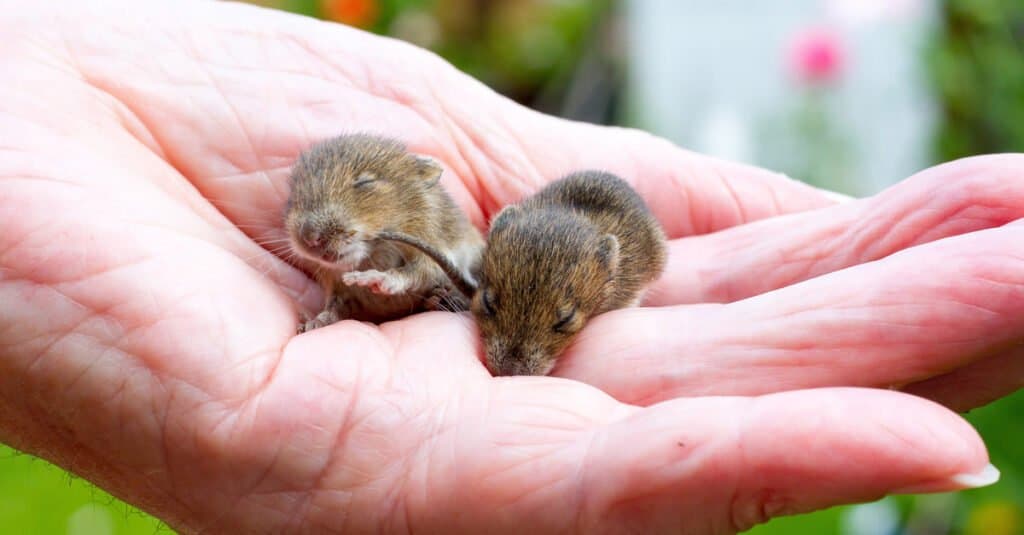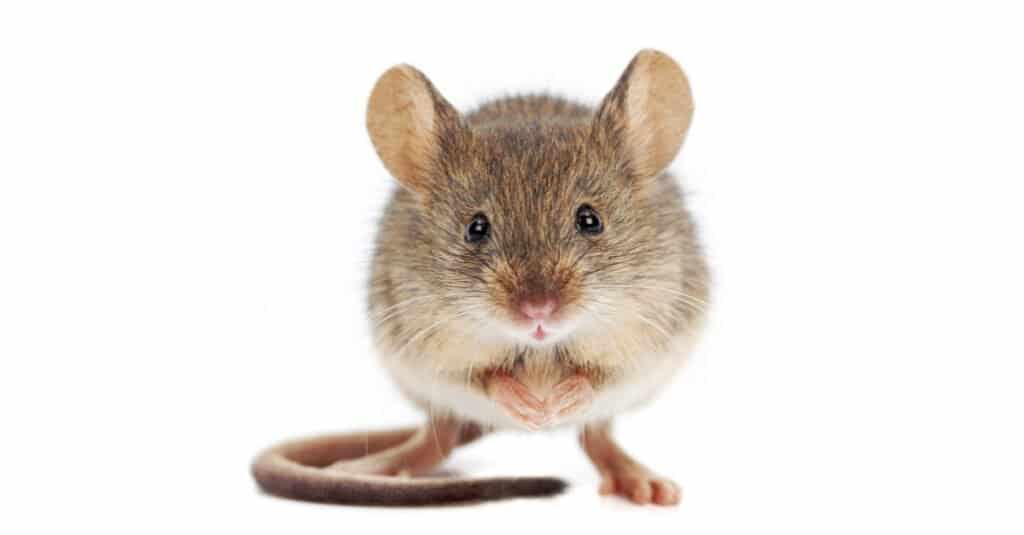Before Buying Pet Mice
Mice live for a very short time, experiencing a lifespan of only 1 to 3 years. Still, they deserve all of the attention and care of any pet. To ensure your new pet mouse is a great fit for you and your household, consider these important things before bringing one home.
Mice are very social animals and need companionship. You can keep multiple females together or even multiple males in the same cage if they are neutered. But remember, males and females breed quickly. So unless you want to be responsible for many of these pets at once, only keep neutered males with females. Neutering also stops males from marking their territory with strong-smelling urine. If you do not neuter the males, you need to keep them in separate habitats.

RELATED: Pet Mice — 9 Things You Need to Know
Mice are resourceful and prone to escaping their habitat if not well secured. Remember your mice can squeeze through very small spaces. The best cages are made of closely-spaced wire or glass with a solid floor that is comfortable on their feet and easy to clean. A wooden floor will quickly develop a strong odor of urine. Their cage should be 2 feet long by at least 1.5 feet wide and 1 foot tall.
Your mice also need lots of entertainment. They enjoy playing, hiding and exercising in a hamster wheel. Like wild mice, they also spend a lot of time chewing. You can provide cardboard and wooden objects for them to chew on.
When choosing your new pets, look for signs of good health in the animals. These signs include shiny, smooth fur and bright, clear eyes. They should appear active and engaged in their surroundings, too. If you want to enjoy having mice for the longest possible time, adopt pups with a full life of one to three years ahead of them.
How much do mice cost?
When you are ready to adopt your own mice, you can easily find them at local pet stores, national pet supply retailers, breeders and animal adoption shelters. In fact, mice are among the most plentiful animals to find for sale as pets. There are also many options on the market for their cages, food and accessories at pet supply stores and online.
Each mouse costs between $5 and $10 from most retailers. This means you can get multiple mice very economically. If you are hesitant to neuter your males, remember that each female mouse can have 15 litters per year with about a dozen mice per litter! This means that an unneutered male could father 180 mice with one female in one year. This is also why it is so easy to buy these pets so cheaply. But a male and female pair can quickly create a nightmarish scenario of more young than you can handle or find buyers to take off your hands. The best way to avoid this dilemma is to buy only female mice as pairs. Females enjoy being in the same cage and will not be aggressive to each other.
Just like for pet hamsters, a cage for your mice will cost about $40. An exercise wheel, an important part of their daily wellness and entertainment, is about $20. Food dishes designed for mice are about $10 and a small animal water bottle is about $15. You will want one of these bottles to keep your mice from spilling the water and making a big mess in their cage.
Bedding costs about $10 to $20 per month. Feeding your mice runs about $10 per month in commercial pet mouse food, vegetables, fruit, seeds and cereals left over from your own daily diet. Mice quickly tear up their toys out of enjoyment of them. So you will likely spend about $20 per mouse to provide them with toys throughout their lifetimes.
In the event your mice get sick, you should always keep about $200 as a budget for veterinary care. In most cases you will not need to spend this money during a mouse’s short lifespan. But the amount should cover anything that can arise in a vet visit.
All of these costs add up to about $150 to bring your pet home with everything they need for the first month. That amount includes the animal itself, its habitat, accessories and starter supplies. From there, you will spend about $20 per month on your mice or less, primarily on food and bedding. Over the course of your rodent’s lifetime, they will cost you between $240 and $720 each for food and bedding, depending on how long they live.

New Owner Shopping List: What to Buy
Buying new pet mice can cause some anxiety as you try to quicky figure out what you need to house, entertain and feed your animals, as well as how you will keep them healthy. There are many things to learn with a new species in your home. Luckily, this can be made much easier if you start with a rodent or small animal habitat starter kit. Starter kits often include everything you need for housing your pet. Starter kits are also available for feeding your mice.
If a starter kit is not your style or you want to start your new pet journey by individually selecting items to suit the needs of your mice, you can follow the shopping list below:
- Cage – The cage or habitat for your mice should be at least 12in long, 12in wide and 12in tall with multiple levels
- Pellet food – Specialized mouse pellet food makes up 75% of your pet’s daily diet
- Fruits and vegetables – You can feed your mice from the same fruits and vegetables you buy for yourself, such as dark leafy greens every other day and banana, melon or apple once weekly
- Bedding – Line the habitat with at least 1 or 2 inches of paper bedding or aspen wood shavings, not cedar shavings, changing this bedding at least once monthly
- Hiding hut – It is important to give your mice a safe, quiet retreat where they can sleep and hideaway as needed
- Chew toys – Mice chew throughout each day and need multiple items like wood toys or blocks to allow them to do this
- Cage Cleaner – Mice are notoriously dirty and need their cage cleaned regularly, such as using specially formulated, non-toxic cage cleaner or warm, soapy water
- Food bowl – A bowl designed for mice should be kept clean and 3/4 filled with pellet food throughout each day
- Water bottle – A small animal water bottle attaches to the side of their habitat and prevents spilled water from leaking into their bedding and creating sanitation problems
- Wheel – An exercise wheel is an important part of your pet’s daily exercise, wellness, stimulation and fun
Ongoing Needs: What You Need to Care for Your Pet Mice
Once you have your pet mice at home, they have ongoing needs. These mostly fall into the categories of food, housing and stimulation. If you provide these things for them, your mice will live happy and healthy lives. Below is a list of what you need to provide for your pet mice on an ongoing basis:
- Pellet food – As mentioned above, your pet mice need their clean food dishes kept 3/4 full of high quality pellet food throughout each day
- Water – Water is essential for any living creature and mice are no different in needing clean, fresh water available to them at all times
- Fruits, vegetables and grains – Your mice need more than just a diet of pellets. To their regular food staple, you should also provide dark leafy greens every other day, fresh fruit once weekly and cereal grains as a treat
- Bedding – Your mice need 1 inch to 2 inches of clean bedding at all times, generally changed during monthly cage cleaning
- Cage cleaner – You can keep a supply of non-toxic cage cleaning solution or use warm, soapy water to maintain your pet’s habitat
- Chew toys – Your pet mice will go through chew toys quickly and need an ongoing supply of new things to capture their attention and provide for teething exercise. Learn more about mouse teeth here.
Exercise and Ongoing Care
When you first take your pet mice home, allow them 3 days in their own habitat before taking them out to handle them. Before holding your pets, wash your hands. They may bite or scratch your hands at first. But they do this from stress and will be less anxious as they get used to you. You should continue handling your pets regularly to bond with them. Besides bonding with you, your mice also need regular exercise and a clean habitat.
Exercise
One of the best ways for your mice to get their daily exercise is through use of a hamster wheel. If you provide one of these wheels in their habitat, they will spend much of every night getting the “run time” that they need to stay healthy. Having a bi-level habitat with ladders, tunnels, ramps and other obstacles will not just keep their interest piqued, but will also help them stay active and fit.
Other options for exercise include a hamster exercise ball. This ball is made of clear plastic for use outside of their cage. Your mouse goes inside of the ball, then self-powers movement all around your house. Just ensure you keep the ball away from stairs and other dangers.
Habitat Cleaning
Keeping your mouse’s habitat clean is crucial for also keeping the animal healthy. Of course, since mice prefer living in pairs and groups, the more mice you have the harder it is to stay on top of the cleaning. You will need to clean their food dishes and refill these daily. Remove debris from their bedding each day. Then, once every few weeks to a month, empty the habitat to wash it from top to bottom. Replace the old bedding with new, fresh aspen wood shavings or other safe material. Never use cedar shavings in the animals’ habitat because these can cause health problems.
Feeding Your Mice
Mice chew throughout each day. This makes them eager to eat anything you put in front of them. That makes it your responsibility to provide them with only healthy foods.
A healthy diet for mice starts with quality mouse diet pellets you find at any pet supply store. You can also buy their food online. 75% of what you feed them each day must consist of these nutritional pellets.
In addition to the pellets, you can feed your mice fruits, vegetables, cereal grains, oats and seeds. Give them dark leafy greens like kale, turnip greens and romaine lettuce every other day. Once weekly, provide a treat of fruits like bananas, berries, melon or apple. You can also treat them with dry oats, cereal grains and seeds.
Of course, your mice need a constant supply of clean and fresh drinking water. It is best to provide the water in a small animal water feeder bottle. These keep the water clean and prevent spilling all over the cage floor.
To learn more about the diet of a mouse, check out this article called “What Do Mice Eat?“
How long will your mice live?
Even the healthiest of mice only live a maximum of 3 years. In fact, many only live just over 1 year. For this reason, it is important to provide them with a happy and healthy life. If you want as much time with your pet mice as possible, buy them when they are pups. And check out this article called “How Long Do Mice Live?“
RELATED: How Old is the Oldest Mouse?
Common Health Issues for Mice
Mice live very short lives. But like any pet, they can easily get sick during their lifetime. Some may even require veterinary care. To prepare for the unfortunate possibility of needing vet care, it helps to set aside about $200 for these emergencies. You will likely never need more than that amount to care for your mice in a health crisis.
Common signs your mouse may be sick include:
- Dull, swollen or sunken eyes
- Lost fur
- Lethargy
- Diarrhea or discolored droppings
- Overgrown teeth
- Not eating or drinking
- Weight changes
- Sneezing
- Runny nose
- Watering eyes or drooling from mouth
Where to Buy Pet Mice
Pet mice are widely available on the market. You can find them through breeders, in national pet supply chain stores, local pet shops and even at your local pet rescue. You can also look online for listings of available pet mice. Because they are among the easiest pets to care for, you do not need any special licenses or permits in most locations. People of any age can usually buy the animals because they make great starter pets.
Mice FAQs
Pet Mouse Guide: What You Need to Know FAQs (Frequently Asked Questions)
Do mice make great pets?
Mice make great pets, particularly for young children first learning how to care for a domesticated animal. They are inexpensive to care for, too. Because they have short lifespans of only 1 to 3 years, mice are not a long-term commitment like dogs, cats and large birds.
What should I know before getting a pet mouse?
Pet mice have short lifespans of only a few years. But they reproduce very quickly. In fact, one female can have up to 15 litters of pups per year. That means that, if you do not separate males and females or get the males neutered, your female mouse may birth up to 180 babies in just one year. Otherwise, mice are happiest in pairs and need companionship from their own kind.
Do mice bond with their humans?
Mice are very social and curious animals, both among other mice and people. If you regularly handle your mice and play gently with them, they will bond with you. They will recognize you by smell, sight and sound, getting excited when you reach in the habitat to pick them up. Of course, it takes time for your mouse to bond and feel safe in your hands. Start holding them after 3 days in their new home to create this bond.
Can I litter train my mice?
You can litter train your pet mice within their habitat. Start by investing in a small animal litter box for their cage. Fill this with litter, place some of their waste in the litter box and introduce the mouse to it. If you see them going to the bathroom in the litter box, provide them with a special treat like a tiny piece of fruit.
How much does a mouse cost?
Pet mice each cost between $5 and $10, in most cases. This means you can buy a pair for just $10 to $20! You also need to provide a cage for about $40, hamster wheel for $20, and food and bedding supplies at the cost of about $20 per month.
Thank you for reading! Have some feedback for us? Contact the AZ Animals editorial team.




